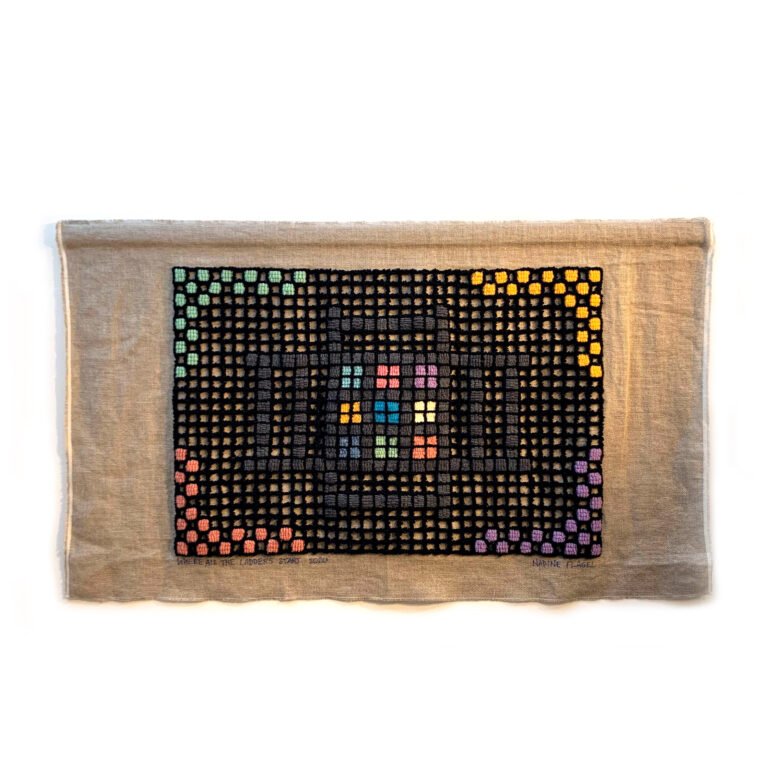In her review of Snagged creative fiber artist and tapestry weaver Barbara Heller expands on the innovative approach to rug hooking that Nadine Flagel has used in the creation of her exhibition. Heller as well brings forth some of the troublesome issues raised by the artist and by audience members engaging with Flagel’s interative work ” Unmade to Measure”

Upon entering the Craft Council of British Columbia to visit the exhibition Snagged by Nadine Flagel, your eyes are immediately drawn to the rich primary colours of Rag Bale I, II, and III hung on the back wall of the gallery space. There is a complex depth that is not evident in photos and on closer inspection you can see that it is not a painting but fabric; hundreds of nubs of multi-hued cloth punched through canvas. This is a far cry from traditional rag rugs. What is happening here?
Nadine’s work may be seen in the context of the slow clothes movement, which holds that we should engage with fashion that took time to make, that evidences the handmade and prioritises sustainability. She uses the language of traditional craft to comment on our current wasteful relation to the fabrics we so thoughtlessly discard in our everyday lives. Where does that sweater with a hole in the sleeve go when we put it in the garbage bin or even, feeling virtuous, in the recycling bin? As Nadine so eloquently states, she is exploring “the implications of fast fashion by restaging and reusing post-consumer textiles…We cannot easily measure or mitigate the overwhelming environmental impacts of textile production and waste.”
“Where does that sweater with a hole in the sleeve go when we put it in the garbage bin or even, feeling virtuous, in the recycling bin?”
While first we notice the sheer beauty and lushness of the cloth used in Rag Bales I, II and III, looking closer we can see many levels. In Harris Tweed Jacket, we see irony in the use of tweed fabric to depict the clothing from which they were cut. There is subtlety in the varying shades, which make both the green and brown variations show the absence of the wearer.
The diptych Rag Yard (Buried Treasure) draws us in to see what is there – can it really be a forklift moving the colourful bales of our discards? The bales are bulging against the restraining straps that barely keep their contents in place. Enhancing the three-dimensional quality of her work, Nadine combines photoprints, paint, beads and hooked (snagged) fabric to add richness to the bleak scene. What is the future of these castoffs?

There are references to traditional hooked rug techniques in Where All the Ladders Start, inspired by a poem by William Butler Yeats (for the artist’s own eloquent words click here). Nadine questions whether creativity can arise only from detritus as Yeats suggests. Could it not also come through a positive reusing of things found in “the rag and bone shop of the heart” and our intimate relationship to what we throw away? I found this to be the least accessible of the works on display and only understood it when I had read the artists own words about the piece.
Perhaps most playful is Unmade to Measure, a mixed media piece modeled after a bar graph. Here, the artist invites the viewer to interact with the work. Using chalk and a series of “yardsticks” covered with differing numbers of hooked squares, we are to write down statements of our choosing and place the yardsticks based on the significance of each phrase. Early on in the exhibition cycle two young women spent time doing just that to express “the privileged descent back to “Normal Life” in the era of Black Lives Matter.” From “George Floyd Murder Video Surfaces” on the left to “Biden Inauguration” and “Back to Brunch” on the right, the two visitors show in graph form how the initial rage relating to the death of George Floyd, among many others, has died down for many (white) folk following the democratic victory in the United States. Like Nadine’s art, this is an appeal that we not go back to life as usual but rather change our habits: our habits in regards to racial insensitivity and our buying habits as well.
In snagged, Nadine Flagel has given us a body of work that rewards time spent looking. There is surface beauty and poignant depths in her appeal to stop and take a closer look at how we interact with the fabric in our lives.



No Comments